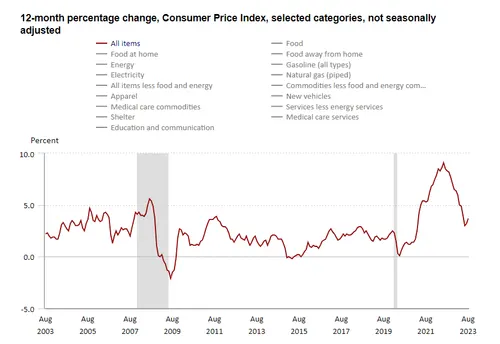Our partner, XM, lets you access a free demo account to apply your knowledge.
No hidden costs, no tricks.

Inflation is one of the most important determinants of market performance. Whether it is the stock, forex, or bond market, inflation drives investor decision making and as market conditions shift, certain financial assets may seem more attractive than others.
Measuring inflation is a complex task and is typically done by central banks and major financial institutions.
Inflation affects monetary policy and prompts central banks to raise interest rates when it is high.
The primary metric for measuring inflation is the Consumer Price Index, or the CPI.
CPI is a crucial economic indicator that measures the average change over time in the prices paid by urban consumers for a market basket of consumer goods and services.
In currency markets, CPI data can significantly affect the performance of currency pairs, while consequent interest rate raises can make bonds more attractive than stocks as long-term investments.
CPI data is released to the public on a periodic basis and can affect the markets in a major way. Institutions often use the CPI as one of the key metrics when it comes to managing their investments.
The Consumer Price Index, or CPI, is an important economic indicator that is used to measure inflation. The index is calculated using a multi-step approach and derives a percentage of inflation that is present at any given time.
Economists and statisticians select a representative "basket" of goods and services that are commonly purchased by an average urban consumer.
This basket includes a lot of different variables and is different from country to country, with some crucial overlapping elements.
This basket typically includes items like food, clothing, rent, healthcare, transportation, and entertainment, which are some of the most common expenditures of economic agents.
Price data for the items in the basket are collected on a regular basis. These prices are obtained from a variety of sources, including retail stores, service providers, and government agencies.
The accuracy of the price data is essential to calculating the Consumer Price Index. Typically, the national statistics service of a country is tasked with researching the prices of every single product and service that goes into the basket of goods.
For example, the United States Bureau of Labor Statistics is the government agency that collects CPI data in the country.
Each item in the basket is assigned a weight based on its relative importance in the average consumer's spending. For example, housing costs might have a higher weight than entertainment expenses.
The weighting also varies from country to country, depending on the composition of the basket of goods and the aggregate average amount spent on each variable.
The price index for each item is calculated by taking the ratio of the current price to the price in a base period (typically a designated reference year).
This ratio is then multiplied by 100 to establish the index number for that item in the base year.
The price indices for all items in the basket are aggregated using the assigned weights. This aggregation results in the overall CPI for a specific period.
The formula used to calculate the Consumer Price Index is as follows:

We can then use this formula to calculate the inflation rate. To determine the inflation rate, you compare the current CPI to the CPI from a previous period (e.g., a month or a year ago) and calculate the percentage change.

As an example, we can look at the U.S CPI data provided by the Bureau of Labor Statistics.

As we can see, the CPI rose sharply in 2021, due to high inflation present in the post-pandemic United States, which was followed by the Federal Reserve’s tightening of monetary policy and interest rate hikes, which helped cool down the economy.
We also saw a major drop in CPI in 2008, when the housing market crash caused prices to fall sharply, causing a recession in the country.
Our partner, XM, lets you access a free demo account to apply your knowledge.
No hidden costs, no tricks.
The Consumer Price Index (CPI) measures the average change in prices paid by urban consumers over time for a specific basket of goods and services. It serves as a key indicator of inflation, reflecting the rising or falling cost of living for an average consumer.
A high Consumer Price Index (CPI) can have mixed implications. Moderate inflation is generally healthy for economic growth, but a persistently high CPI can erode purchasing power and lead to economic instability. Central banks aim to maintain stable, moderate inflation levels for a balanced economy.
In the Consumer Price Index (CPI), a "basket of goods" refers to a representative selection of goods and services that an average urban consumer typically purchases. These items are used to calculate changes in the cost of living over time, reflecting inflation or deflation trends.